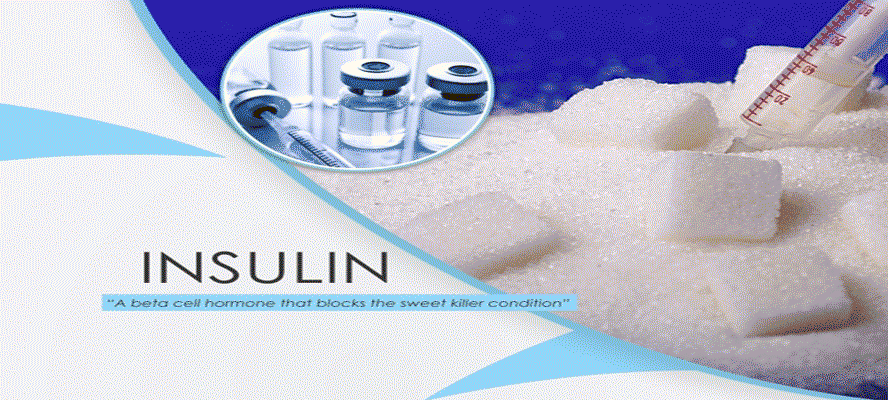"Diabetes", a metabolic disorder affecting majority of the population world over, is known
to mankind and is in existence for many decades now. Research directed to find the exact
cause for this condition, brought out the existence of "insulin", the principle hormone that
controls sugar levels.
Every kid is introduced to magic early in childhood. The fascination of things happe ning with just a snap of fingers,
twitch of a nose, magical wands, fairy dust or magical potions is known not only to kids, but intrigues the adult
generation as well. Nonetheless, we are so engrossed in fiction that we tend to forget the reality of life; say our
body's biological mechanics which is nothing but magical. Ever wondered how the food that we eat, rightly gets
digested and absorbed by the tiny cells of our body? (Mind you, food and water are the only means of human sustenance!)
Ever imagined how the whole foolproof procedure of absorption of food in our body works so meticulously? The one word
answer to it is - Insulin!
Magic that is biologically rooted in our body, saves us after every meal!
When we observe our body at a cellular level, the food (carbohydrates, fats, etc.) that we consume is broken down
into sugar (glucose); this sugar (that cannot enter the cells directly) needs a pass key to enter the cells of the
body. Beta cells in the pancreas are signaled to release Insulin in the bloodstream, which acts as the pass key for
entry of glucose in the cells. After a heavy meal, the levels of glucose in the
blood shoots up, which is compensated by the release of insulin that allows the glucose to enter the cells and carry out
cellular respiration (a cycle that uses up glucose to generate energy in the form of ATP). Also, very high levels of sugar
in the body is stored in liver (again with the help of insulin) to be used up when blood sugar levels are low.
This symphony of insulin, a biochemical/hormonal activity of the body, at a cellular level is more like an enchantment,
most often gone unnoticed. Also, ever growing sedentary lifestyle and unreasonable food habits have become the sole
reason for fluctuations at cellular level, again gone unnoticed! Exceeding to a limit where the body cannot take it
anymore and starts showing signs and symptoms of deteriorating health. In case of insulin fluctuations, when the body
does not produce enough insulin (type 1 diabetes) or the cells of the body become resistant to insulin (type 2 diabetes),
an individual develops hyperglycemic condition that renders long term complications like nephropathy, neuropathy,
fertility issues, etc., if unattended.
Yet again, insulin comes to the rescue in battling the diabetic condition in the form of treatment/medication. So when
the body is unable to naturally release insulin (or becomes resistant to it) to maintain homeostasis of energy and
metabolism, this hormone is injected as an external source to aid the body. The various types of insulin used to treat
diabetes is based on the peculiar characteristics of insulin to be injected, those are,
Characteristics of Insulin
- Onset - length of time before insulin reaches the blood
stream to lower blood glucose
- Peaktime-time during which insulin is at maximum strength
to lower blood glucose
- Duration - for how long does insulin continue to lower blood glucose
Insulin is a biologically active monomerie molecule composed of two chains
of amino acids-A and B chain. Both the chains, connected by a disulphide bridge are
composed of 21 and 30 amino acids, respectively.
Mode of action
Insulin and glucagon are the two principle hormones secreted by the pancreas and are
involved in maintaining blood sugar levels. The ideal blood glucose levels are expected
to be between 70 - 100 mg/dL. During conditions of hypoglycemia (low blood glucose),
the alpha cells of pancreas are triggered to release glucagon, which aids in release of glucose
from liver and also for breakdown of other stored forms of energy to release glucose. During
conditions of hyperglycemia (high blood glucose levels), the beta cells of pancreas are stimulated
to release insulin, which triggers the different body cells to absorb glucose, resulting in lowering
the net blood glucose levels.
Insulin aids in maintaining blood glucose levels by
1. Facilitating uptake of blood glucose by adipose
tissue, muscle cells, etc.
2. Stimulating liver to store excess glucose as
glycogen, another stored form of energy
Apart from glucose level maintenance, insulin is also involved in promoting fatty
acid synthesis, stimulating uptake of amino acids, preventing fat breakdown, etc.
Insulin in diabetes treatment
Until the 1980s, pancreas from animals like dogs and pigs were widely used for insulin
production. But with increase in the number of affected with type II diabetes (inability
to utilise insulin), the demand for external supply of insulin increased. Hence, the focus
of research shifted to using highly advanced technology for synthesising artificial human
insulin in high quantities
Synthesis of Insulin
Few popularly used techniques for insulin production include:
- Recombinant DNA Technology (RDT)
This involves insertion of the human insulin coding gene into plasmid from a bacteria.
Once within the bacteria, the genes are triggered to synthesise either the A or B chains
of insulin. When sufficient A and B chains are produced by the cells, they are harvested
and purified.
The two chains are then combined chemically in the lab to form a complete insulin
molecule which is identical to that produced by humans .
Pancreatic transplantation
Transplantation of pancreas has emerged to be a great treatment strategy especially
for recovery from type I diabetes, as this move can completely negate use of external
insulin requirement. However, limitation in the number of donors, along with higher
chances of graft rejection are the major blocks in most of the cases.
- Insulin pump
It is a device for the treatment of diabetes mellitus, which is attached to the skin and
delivers the required amount of insulin through a catheter placed under the skin. The
slow release mechanism of the insulin pump mimics working of pancreas and efficiently
metabolises
sugar. It is found to be very effective compared to multiple insulin injections
in treating diabetes.
Working of insulin pump
An insulin pump supplies insulin 24 hrs either rapidly or in a slow release fashion as per the
requirements, through a catheter. The insulin gets released in 3 doses .
1. Basal dose
This dose involves continuous release of insulin for 24 hrs to maintain a balance of
blood sugar levels between food intake intervals.
2. Bolus dose
Post any meal, the glucose levels sharply increases, and to counter this surge,
a high level bolus dose of insulin is released.
3. Correction of supplemental doses
In case of high blood glucose levels, before a meal intake, this corrective dosage helps
to regulate high glucose levels.
Advantages of insulin pump
1. Prevents inconvenience caused by frequent insulin injections.
2. Improves the average blood glucose levels i.e. HbA1c level.
3. Reduces episodes of very low or high insulin levels.
4. Prevents the harmful effects of long-lasting insulin in blood.
5. Prevents rapid changes in blood glucose levels which are common episodes in
insulin injection cases.
6. No restrictions in meal timings, due to flexibility provided by the pump.
Few disadvantages include inconvenience to carry around as it is attached to the
body, expensive and can malfunction.
All said and done,
it is still better to bring in harmony in the world with respect to diabetes by inculcating lifestyle changes
such as nutritional balanced diet, regular exercise, controlling blood pressure, etc.





















































